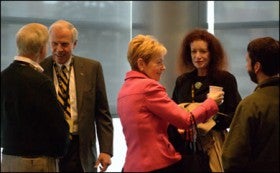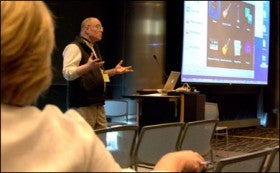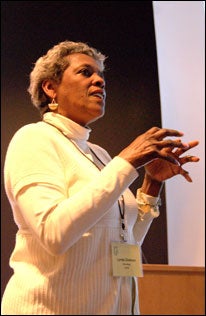Educators share in serious fun at learning conference
CU President Bruce D. Benson, second from left; his wife, Marcy Benson, center; and Mary Ann Shea, director of the President's Teaching Scholars Program, chat with attendees of the program's sponsored conference on Friday, March 5, at the Anschutz Medical Campus. The daylong event consisted of presentations and panel discussions on the topic "How Our Students Learn: Implications for Faculty."
Photo/Caroline SeibCU President Bruce D. Benson, second from left; his wife, Marcy Benson, center; and Mary Ann Shea, director of the President's Teaching Scholars Program, chat with attendees of the program's sponsored conference on Friday, March 5, at the Anschutz Medical Campus. The daylong event consisted of presentations and panel discussions on the topic "How Our Students Learn: Implications for Faculty."
Some 100 faculty members from throughout the University of Colorado system gathered Friday, March 5, to talk shop at the President's Teaching Scholars Program (PTSP) conference. The daylong lineup of presentations and panel discussions took aim at the topic "How Our Students Learn: Implications for Faculty."
The unofficial theme might have been "Serious Fun," thanks to presentations that mingled playfulness with scholarship. In their presentation on teaching procedural skills, husband-and-wife Matt and Katie Rustici, second-year residents at the Anschutz Medical Campus, showed a clip from the TV comedy "Scrubs" and handed out toddler shoes to the audience for an exercise in automated processes. It turned out that tying a shoe with your non-dominant hand is a much more difficult task than imagined.
Ed Rivers, professor and President's Teaching Scholar with the English department at CU-Boulder, tinkered with Apple's Garage Band program to show how the metaphorical right brain and left brain can be put into action simultaneously. The program, which enables easy composition of music via canned loops and sounds, can lead to revelatory communication, he said: One student's seemingly senseless cacophony of videogame music and effects turned out to be an articulation of what it feels like to endure bipolar disorder.
Professor Ed Rivers of the English department at the University of Colorado at Boulder presents a session during the President's Teaching Scholars Program conference. He demonstrated Apple's Garage Band program to show how its use relies on the metaphorical left and right sides of the brain.
Photo/Caroline SeibProfessor Ed Rivers of the English department at the University of Colorado at Boulder presents a session during the President's Teaching Scholars Program conference. He demonstrated Apple's Garage Band program to show how its use relies on the metaphorical left and right sides of the brain.
"I was very moved by the project and by the student's expression," Rivers said.
For the day's plenary address, Jerry Rudy, psychology professor at CU-Boulder, took the audience on a fantastic voyage of sorts with his "Hitchhiker's Guide to How the Brain Learns and Remembers." Slides and animation showed how memories form like popcorn erupting on spiny neurons. He discussed what sounds like science fiction: erasure of specific memories from the mind. It's real science that's currently being researched, he said.
The event also featured serious contemplation, such as four professors from the University of Colorado at Colorado Springs, all women of color, who led a panel discussion on the challenges such educators face.
"What do you need to look like, speak like, dress like ... for students to respect your authority?" said Rashna B. Singh, an English professor. Lynda Dickson, a sociology professor, related the story of a critical "e-mail from hell" sent by a student, and the ensuing question it raises: Is the criticism racially motivated?
Professor Jerry Rudy of the psychology department at the University of Colorado at Boulder lectures during the plenary session at the President's Teaching Scholar Program conference at the Anschutz Medical Campus. In his talk, "The Hitchhiker's Guide to How the Brain Learns and Remembers," he discussed the process of forming memories and the new possibility of deleting specific memories.
Photo/Caroline SeibProfessor Jerry Rudy of the psychology department at the University of Colorado at Boulder lectures during the plenary session at the President's Teaching Scholar Program conference at the Anschutz Medical Campus. In his talk, "The Hitchhiker's Guide to How the Brain Learns and Remembers," he discussed the process of forming memories and the new possibility of deleting specific memories.
Marty Bickman, professor and President's Teaching Scholar with the English department at CU-Boulder, showed the other end of the spectrum during his presentation, "How Our Students Learn: Why Not Ask Them?" He led a panel of three Boulder graduate students who also teach; they talked about educators and students working together. "It seems to me we ought to ally with our students," Bickman said.
udy Strathearn said it's a good idea for grad students to teach "because we're on both sides of the fence." Her advice to educators: "Be who you are every day when you walk into the classroom," she said. "Let (students) see who you really are."
The event opened with a welcome from Mary Ann Shea, director of the PTSP, a presidential initiative that endorses excellence in teaching by honoring faculty throughout the university who excel in teaching, scholarship and research. CU President Bruce D. Benson also spoke and answered questions, including one about his own time as an undergraduate at CU-Boulder.
"I had a wonderful experience," Benson said, noting that he was "not a partying guy."
"I had great professors," he added, mentioning Bruce Curtis as his adviser and favorite professor. In 2002, after Benson and his wife, Marcy, made a donation to the CU-Boulder Museum of Natural History, the building was renamed the Bruce Curtis Building in honor of the professor emeritus.
Professor Lynda Dickson of the University of Colorado at Colorado Springs sociology department addresses the audience during "Teaching Back: When 'true speaking' in the classroom is seen as threat," a panel discussion during the President's Teaching Scholar Program (PTSP) conference at the Anschutz Medical Campus on Friday, March 5.
Photo/Caroline SeibProfessor Lynda Dickson of the University of Colorado at Colorado Springs sociology department addresses the audience during "Teaching Back: When 'true speaking' in the classroom is seen as threat," a panel discussion during the President's Teaching Scholar Program (PTSP) conference at the Anschutz Medical Campus on Friday, March 5.





